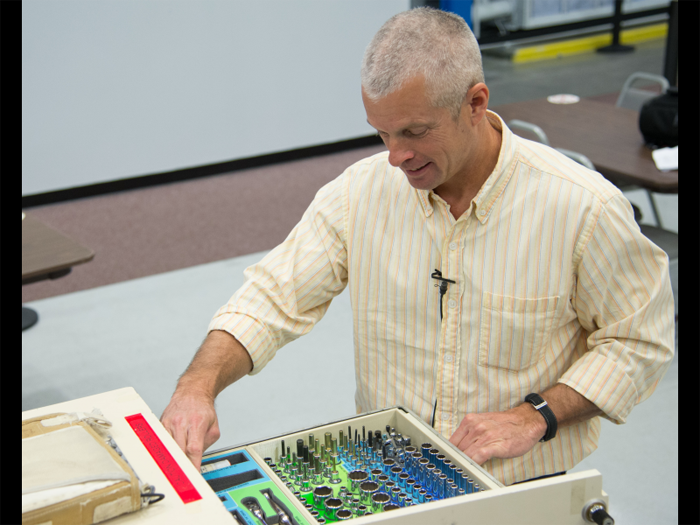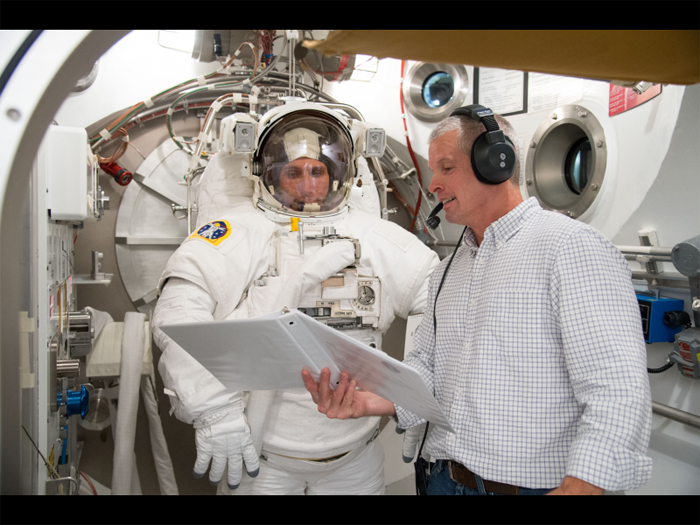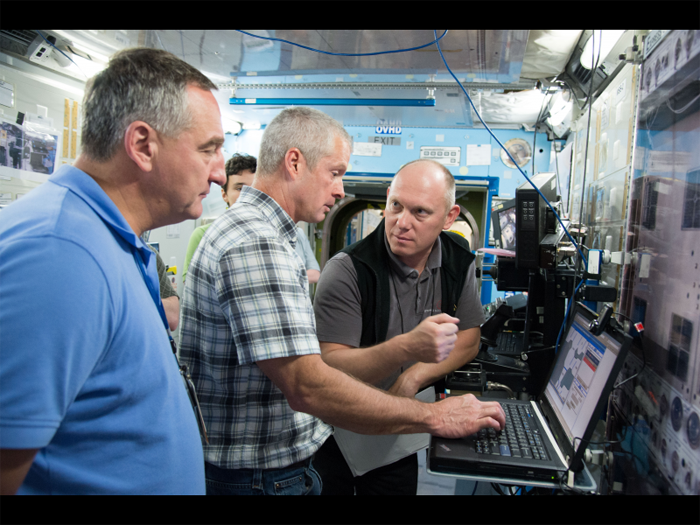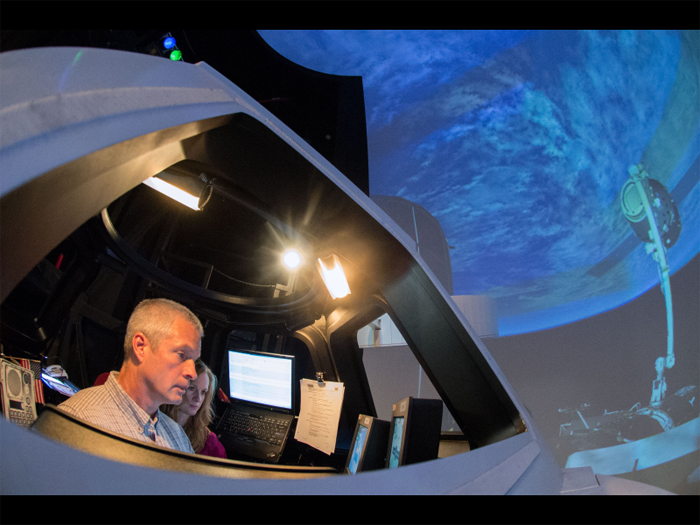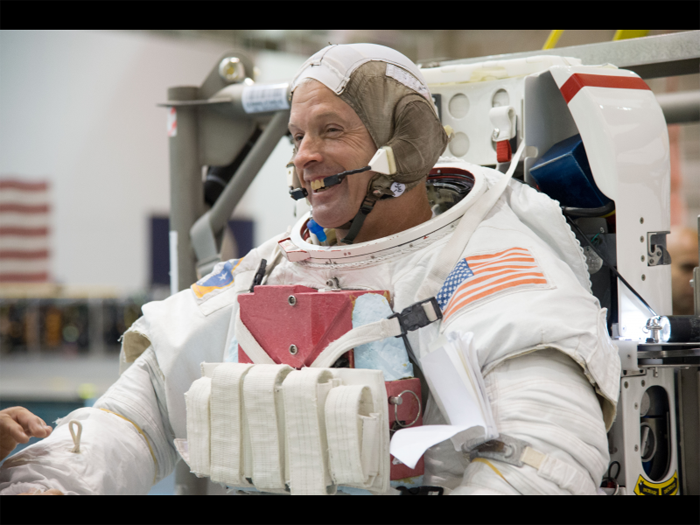.

NASA astronaut Michael Hopkins, Expedition 37/38 flight engineer, participates in an Extravehicular Mobility Unit (EMU) spacesuit fit check in the Space Station Airlock Test Article (SSATA) of the Crew Systems Laboratory at NASA's Johnson Space Center. NASA astronaut Steve Swanson, Expedition 39 flight engineer and Expedition 40 commander, assisted Hopkins. Photo credit: NASA
.

JSC2013-E-028681 (3 May 2013) -- Russian cosmonaut Oleg Kotov (left), Expedition 37 flight engineer and Expedition 38 commander; along with NASA astronaut Michael Hopkins (center) and Russian cosmonaut Sergey Ryazanskiy, both Expedition 37/38 flight engineers, participate in a routine operations training session in an International Space Station mock-up/trainer in the Space Vehicle Mock-up Facility at NASA's Johnson Space Center. Photo credit: NASA
.

JSC2013-E-027497 (25 April 2013) -- NASA astronaut Michael Hopkins, Expedition 37/38 flight engineer, is visible on the screens in the Space Station Airlock Test Article (SSATA) Control Room in the Crew Systems Laboratory at NASA's Johnson Space Center during an Extravehicular Mobility Unit (EMU) spacesuit fit check. Photo credit: NASA
.

JSC2013-E-009155 (24 Jan. 2013) -- Russian cosmonaut Oleg Kotov (center), Expedition 37 flight engineer and Expedition 38 commander; along with NASA astronaut Michael Hopkins (left) and Russian cosmonaut Sergey Ryzansky, both Expedition 37/38 flight engineers, participate in an emergency scenario training session in an International Space Station mock-up/trainer in the Space Vehicle Mock-up Facility at NASA's Johnson Space Center. Photo credit: NASA
.

JSC2012-E-237838 (9 Nov. 2012) -- NASA astronaut Michael Hopkins, Expedition 37/38 flight engineer, prepares for a flight in a NASA T-38 trainer jet at Ellington Field near NASA's Johnson Space Center. Photo credit: NASA
.

SS037-S-001 (August 2012) -- Leonardo da Vinci's Vitruvian Man, created some 525 years ago, as a blend of art and science and a symbol of the medical profession, is depicted amongst the orbits of a variety of satellites circling the Earth at great speed. Da Vinci's drawing, based on the proportions of man as described by the Roman architect Vitruvius, is often used as a symbol of symmetry of the human body and the universe as a whole. Almost perfect in symmetry as well, the International Space Station, with its solar wings spread out and illuminated by the first rays of dawn, is pictured as a mighty beacon arcing upwards across our night skies, the ultimate symbol of science and technology of our age. Six stars represent the six members of Expedition 37 crew, which includes two cosmonauts with a medical background, as well as a native of Da Vinci's Italy. The design for insignia for space station flights is reserved for use by the crew members and for other official use as the NASA Administrator may authorize. Public availability has been approved only in the form of illustrations by the various news media. When and if there is any change in this policy, which is not anticipated, it will be publicly announced.
.

SC2013-E-007021 (18 Jan. 2013) -- Japan Aerospace Exploration Agency (JAXA) astronaut Koichi Wakata, Expedition 38 flight engineer and Expedition 39 commander, participates in an exercise in a Cupola trainer in the systems engineering simulator in the Avionics Systems Laboratory at NASA's Johnson Space Center. The facility includes moving scenes of full-sized International Space Station components over a simulated Earth. Photo credit: NASA
.

JSC2012-E-237298 (5 Nov. 2012) -- NASA astronaut Rick Mastracchio (left), Expedition 38/39 flight engineer; and Japan Aerospace Exploration Agency (JAXA) astronaut Koichi Wakata, Expedition 38 flight engineer and Expedition 39 commander, uses the virtual reality lab in the Space Vehicle Mock-up Facility at NASA's Johnson Space Center to train for some of their duties aboard the International Space Station. This type of computer interface, paired with virtual reality training hardware and software, helps to prepare crew members for dealing with space station elements. Photo credit: NASA
.

JSC2012-E-237314 (5 Nov. 2012) -- Japan Aerospace Exploration Agency (JAXA) astronaut Koichi Wakata (left), Expedition 38 flight engineer and Expedition 39 commander; along with NASA astronauts Rick Mastracchio (center), Expedition 38/39 flight engineer; and Michael Hopkins, Expedition 37/38 flight engineer, are pictured during a training session in the virtual reality lab in the Space Vehicle Mock-up Facility at NASA's Johnson Space Center. Photo credit: NASA
.

JSC2012-E-048058 (22 March 2012) -- Japan Aerospace Exploration Agency (JAXA) astronaut Koichi Wakata, Expedition 38 flight engineer and Expedition 39 commander, gets help donning a training version of his Extravehicular Mobility Unit (EMU) spacesuit in preparation for a spacewalk training session in the waters of the Neutral Buoyancy Laboratory (NBL) near NASA's Johnson Space Center. Photo credit: NASA
.

JSC2012-E-237343 (5 Nov. 2012) -- Japan Aerospace Exploration Agency (JAXA) astronaut Koichi Wakata, Expedition 38 flight engineer and Expedition 39 commander, uses the virtual reality lab in the Space Vehicle Mock-up Facility at NASA's Johnson Space Center to train for some of his duties aboard the International Space Station. This type of computer interface, paired with virtual reality training hardware and software, helps to prepare crew members for dealing with space station elements. Photo credit: NASA
.

JSC2012-E-237330 (5 Nov. 2012) -- NASA astronaut Michael Hopkins, Expedition 37/38 flight engineer, uses virtual reality hardware in the Space Vehicle Mock-up Facility at NASA's Johnson Space Center to rehearse some of his duties on the upcoming mission to the International Space Station. This type of virtual reality training allows the astronauts to wear a helmet and special gloves while looking at computer displays simulating actual movements around the various locations on the station hardware with which they will be working. Photo credit: NASA
.

JSC2013-E-013783 (6 March 2013) -- Japan Aerospace Exploration Agency (JAXA) astronaut Koichi Wakata, Expedition 38 flight engineer and Expedition 39 commander, participates in a Robonaut task board training session in the Space Vehicle Mock-up Facility at NASA's Johnson Space Center. Photo credit: NASA
.

JSC2013-E-021295 (28 March 2013) -- Japan Aerospace Exploration Agency (JAXA) astronaut Koichi Wakata (right), Expedition 38 flight engineer and Expedition 39 commander; and NASA astronaut Rick Mastracchio, Expedition 38/39 flight engineer, attired in training versions of their Extravehicular Mobility Unit (EMU) spacesuits, participate in a spacewalk training session in the waters of the Neutral Buoyancy Laboratory (NBL) near NASA's Johnson Space Center. Divers are in the water to assist Wakata and Mastracchio in their rehearsal, which is intended to help prepare them for possible work on the exterior of the International Space Station. Photo credit: NASA
.

